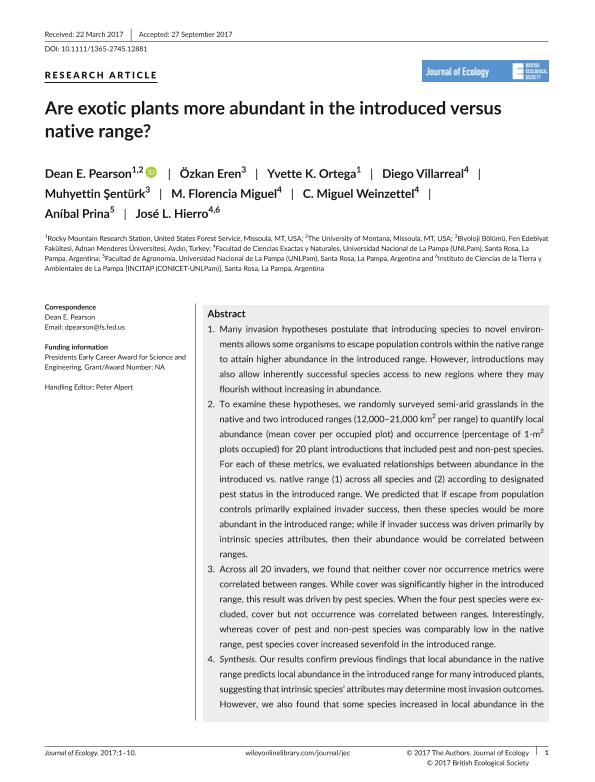Mostrar el registro sencillo del ítem
dc.contributor.author
Pearson, Dean

dc.contributor.author
Eren, Ozkan

dc.contributor.author
Ortega, Yvette K.
dc.contributor.author
Villarreal, Diego

dc.contributor.author
Sentürk, Muhyettin
dc.contributor.author
Miguel, María Florencia

dc.contributor.author
Weinzettel, Cristian Miguel

dc.contributor.author
Prina, Anibal Oscar

dc.contributor.author
Hierro, Jose Luis

dc.date.available
2018-04-09T19:25:19Z
dc.date.issued
2017-12
dc.identifier.citation
Pearson, Dean; Eren, Ozkan; Ortega, Yvette K.; Villarreal, Diego; Sentürk, Muhyettin; et al.; Are exotic plants more abundant in the introduced versus native range?; Wiley Blackwell Publishing, Inc; Journal of Ecology; 106; 2; 12-2017; 1-10
dc.identifier.issn
0022-0477
dc.identifier.uri
http://hdl.handle.net/11336/41403
dc.description.abstract
Many invasion hypotheses postulate that introducing species to novel environments allows some organisms to escape population controls within the native range to attain higher abundance in the introduced range. However, introductions may also allow inherently successful species access to new regions where they may flourish without increasing in abundance.
To examine these hypotheses, we randomly surveyed semi‐arid grasslands in the native and two introduced ranges (12,000–21,000 km2 per range) to quantify local abundance (mean cover per occupied plot) and occurrence (percentage of 1‐m2 plots occupied) for 20 plant introductions that included pest and non‐pest species. For each of these metrics, we evaluated relationships between abundance in the introduced vs. native range (1) across all species and (2) according to designated pest status in the introduced range. We predicted that if escape from population controls primarily explained invader success, then these species would be more abundant in the introduced range; while if invader success was driven primarily by intrinsic species attributes, then their abundance would be correlated between ranges.
Across all 20 invaders, we found that neither cover nor occurrence metrics were correlated between ranges. While cover was significantly higher in the introduced range, this result was driven by pest species. When the four pest species were excluded, cover but not occurrence was correlated between ranges. Interestingly, whereas cover of pest and non‐pest species was comparably low in the native range, pest species cover increased sevenfold in the introduced range.
Synthesis. Our results confirm previous findings that local abundance in the native range predicts local abundance in the introduced range for many introduced plants, suggesting that intrinsic species’ attributes may determine most invasion outcomes. However, we also found that some species increased in local abundance in the introduced range, suggesting that changes in biogeographic context may also play an important role. While these latter species were pests, the small sample size precluded strong inferences. Determining what underlies the success of invasive pests remains elusive due to their low representation among introduced species.
dc.format
application/pdf
dc.language.iso
eng
dc.publisher
Wiley Blackwell Publishing, Inc

dc.rights
info:eu-repo/semantics/openAccess
dc.rights.uri
https://creativecommons.org/licenses/by-nc-sa/2.5/ar/
dc.subject
Biogeography
dc.subject
Invasion
dc.subject
Local Abundance
dc.subject
Occurrence
dc.subject.classification
Otras Ciencias Biológicas

dc.subject.classification
Ciencias Biológicas

dc.subject.classification
CIENCIAS NATURALES Y EXACTAS

dc.title
Are exotic plants more abundant in the introduced versus native range?
dc.type
info:eu-repo/semantics/article
dc.type
info:ar-repo/semantics/artículo
dc.type
info:eu-repo/semantics/publishedVersion
dc.date.updated
2018-04-09T15:05:13Z
dc.journal.volume
106
dc.journal.number
2
dc.journal.pagination
1-10
dc.journal.pais
Reino Unido

dc.journal.ciudad
Londres
dc.description.fil
Fil: Pearson, Dean. United States Department of Agriculture; Estados Unidos. University of Montana; Estados Unidos
dc.description.fil
Fil: Eren, Ozkan. Adnan Menderes Universitesi; Turquía
dc.description.fil
Fil: Ortega, Yvette K.. United States Department of Agriculture; Estados Unidos
dc.description.fil
Fil: Villarreal, Diego. Universidad Nacional de la Pampa. Facultad de Ciencias Exactas y Naturales. Departamento de Ciencias Naturales; Argentina
dc.description.fil
Fil: Sentürk, Muhyettin. Adnan Menderes Universitesi; Turquía
dc.description.fil
Fil: Miguel, María Florencia. Universidad Nacional de la Pampa. Facultad de Ciencias Exactas y Naturales. Departamento de Ciencias Naturales; Argentina. Consejo Nacional de Investigaciones Científicas y Técnicas; Argentina
dc.description.fil
Fil: Weinzettel, Cristian Miguel. Universidad Nacional de la Pampa. Facultad de Ciencias Exactas y Naturales. Departamento de Ciencias Naturales; Argentina
dc.description.fil
Fil: Prina, Anibal Oscar. Universidad Nacional de la Pampa. Facultad de Ciencias Exactas y Naturales. Departamento de Ciencias Naturales; Argentina
dc.description.fil
Fil: Hierro, Jose Luis. Consejo Nacional de Investigaciones Científicas y Técnicas. Instituto de Ciencias de la Tierra y Ambientales de La Pampa. Universidad Nacional de La Pampa. Facultad de Ciencias Exactas y Naturales. Instituto de Ciencias de la Tierra y Ambientales de La Pampa; Argentina
dc.journal.title
Journal of Ecology

dc.relation.alternativeid
info:eu-repo/semantics/altIdentifier/url/https://besjournals.onlinelibrary.wiley.com/doi/abs/10.1111/1365-2745.12881
dc.relation.alternativeid
info:eu-repo/semantics/altIdentifier/doi/http://dx.doi.org/10.1111/1365-2745.12881
Archivos asociados
